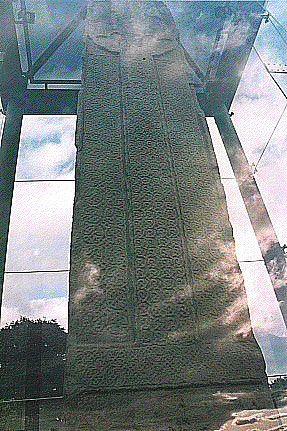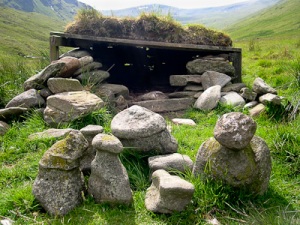At the head of Glen Lyon, hidden away from the unseeing eyes of modern man–and his pragmatic concepts of our pre-Celtic sacred past–is a pre-Christian shrine whose tradition has been maintained through the centuries. A sacred ritual, kept from time immemorial–and still maintained to this day on Beltane and Samhain (May Day and ‘All Hallows’) by a few descendants–ensures that the Crooked Stones of the Black Glen (Gaelic,Gleann Dubh nan Garbh Clac) come out of their hole into the sunshine of summer and return to their hole for winter months. That ‘hole’ is the sacred bosom of the Earth Mother herself whose traditions long pervaded pre-Celtic culture of the North Britons. When Christianity came to the northern shores, some of these traditions were shielded from prying eyes–but ritual continued–other traditions were ‘lost’.
“On the Feast Day of Bride
The serpent shall come from its hole
I shall not molest the serpent
Nor shall the serpent molest me“
This is an almost forgotten rhyme (original in Irish Gaelic) which was spoken on the Feast Day of Bride (Imbolc, Oimelc, Candlemas, February 2, St.Brigid’s Day), at the first glimpse of sunlight after the long winter months. the serpent (so demeaned and debased by the Christian church as evil betrayer) is symbolic both of knowledge (medical caduceus) and the Kundalini Lifeforce of the Spirit and simple rising sap in Nature. Bride was the pagan goddess of the Earth in her Virginal-girlhood guise. She is seen as the Mother goddess during summer months when she provides all the bounty of the Earth; and as the Crone, or Cailleach (‘hag’) in the waning months of the year. She is the Cailleach of the Stones at Glen Lyon when she returns to her ‘hole’ on November 1st.
The Glen Lyon ‘hole’ is a rough shelter (Tigh) to house the stones–a lovingly-tended shelter which speaks volumes about its unsung guardians. In comparison with such ‘shelters’ erected at massive cost to the taxpayer by government agencies for other stones, this little shelter is a miracle in time-honored tradition alone.
Jamie Grant, secretary of Glen Lyon History Society has lived in Glenlyon, known in Gaelic as Gleann Dubh nan Garbh Clac (the black Glen of the crooked Stones), for the last ten years. During this time he loves to visit one remote spot more than any other.
To reach it you have to drive to the road’s end at Pubil, where the Lubreoch hydro-electric damn (sic) holds back the waters of Loch Lyon. From here a small track skirts the north shore of the loch, into the Glen’s most westerly marches”
“This land between Loch Lyon and the Bridge of Orchy feels truly wild. Miles from anywhere the mountains, scored with tumbling burns, take complete hold over the landscape. Scramble to the summit of Beinn á Chreachin on a clear day and you can see the Ben Lawers massif, Rannoch Moor, Glen Coe and even the humped cap of Ben Nevis in the far distance.”
Planning was lodged last month for four run-of-river hydro schemes on the Auch Estate in Glenlyon. One of these proposed schemes in Gleann Cailliche threatens an ancient and uninterrupted link to our fast-diminishing heritage of pre-Celtic Pictland/Scotland.
Glen Lyon views and rare Arctic-alpine habitats are suberb. There is already a dam feeding much needed water, but any increase in road traffic or development will forever mar what the locals enjoy. They have–philosophically– learned to live with the alternative over the centuries: man’s encroachment.
Particularly now in 21stC, road-making and access-provision equipment is no longer manufactured on a scale which takes the environment into consideration. Sixteen-wheelers are the ‘norm’ in deliveries from household coal to house ‘kits’.
Jamie wrote the following about the proposal for the new accesses and hydro-electric pylons which are planned for erection. All dowsers know of the disruption to ancient geomatric energy when an electricity supply crosses over an ancient sacred site–in particular one where sacred honoring and tradition have been maintained.
Pylons to be erected with high-voltage wires strung over this site will destroy its unique connection to the very landscape it seeks to honor.
While planning objections had to be lodged before March 18th, 2011, there is still time to make one’s opinion heard: The First Minister, Scots Parliament and Historic Scotland should be approached, if you feel strongly enough to save this unique sacred spot.
“Tucked away in Gleann Cailliche, a hidden glen of boggy heath and mist, is the ancient shrine of Tigh nam Bodach. The shrine is made up of a modest stone structure that houses a family of bell shaped water stones from the river bed of the Lyon. The largest represents the Cailleach (old woman), accompanied by the Bodach (old man) and their daughter, Nighean.“The Tigh nam Bodach is recognized as the oldest site of uninterrupted pagan ritual in Britain–some say in all of Europe. For centuries the family of stones are taken out of their house every spring and stood to face down the Glen. At the beginning of November they are carefully shut back up inside their house, where they shelter through the winter. The ritual coincides with the two great Celtic fire festivals, Beltane (May Day) and Samhain (‘All-Saints’ Day), and once echoed the annual migrations of the Highland cattle to and from the summer shielings.”
[Samhain was the beginning of the Celtic calendar year. Ed]
“The shielings may be long abandoned, but the practice of tending to the stones is still observed to this day. Residents and other visitors who know of the stones also walk to the site throughout the year. The Tigh nam Bodach is a unique part of Glenlyon’s heritage and an unbroken connection to our pre-Celtic ancestors.
“The Cailleach, or divine Old Goddess, is a potent force in Celtic mythology.
First recorded as the Cailleach Bhéarra of the Beara peninsula in southern Ireland, she was once revered across Ireland and Scotland. Commonly associated with wild nature and landscape, in the Western Isles, the Cailleach is credited with creating Scotland’s elemental fringes (including the Hebrides).
“A local legend says that Loch Tay was formed when she forgot to leave a flagstone lid on a magical spring well.”
“A fearsome Cailleach was said to live on Perthshire’s Beinn à Ghlotha. In legend she was a terrifying hag that could take the form of any wild animal and loved nothing more than to drown travellers in pools of water with the lure of false treasure.
“Glen Lyon’s Cailleach is more benign. She is remembered for looking after the cattle that once grazed these high grounds. ‘Strange and terrible’ things are said to happen to anyone who dares disturbs her wintering grounds in Gleann Cailliche.”
Planning permission recently lodged for four hydro electric schemes will forever transform the Gleann Cailliche and the surrounding landscape.
Existing tracks will be upgraded to take heavy traffic.
Power houses will be constructed, borrow pits dug and fresh tracks will be carved into the steeply sided slopes to weirs.
An overhead power line will be run past the Tigh nam Bodach and down the side of Loch Lyon.
Jamie Grant continues:

Typical government-agency 'greenhouse-cooked' shelter for Sueno Stone, Forres, Moray. cf rude shelter in Glen Lyon
“What the planners are unlikely to appreciate, for all their cleverly worded ‘mitigation measures,’ is that the Cailleach represents the whole landscape.
“Of course, these run-of-river schemes have their benefits. They generate much needed renewable energy to help tackle climate change. They are far less visually-intrusive than vast onshore windfarms. They also help support cash-strapped estates at time of financial uncertainty. But for all the positives, I am still convinced that a few of our wildest places should be kept free of industrial development.
“Surely Gleann Cailliche, with its unbroken link to our deep past, is one of them.
“We would do well to remember that in Celtic legend the goddess of the wilds was not immortal.”
“In one old tale from Mull the Cailleach immersed herself in the waters of Loch Bà every one hundred years to replenish her youth and beauty. As she descended one morning out of the hills to take the loch’s elixir of life she heard the bark of a shepherd’s collie (representing the domestication of animals and landscape). Pausing to listen, her hundred years timed out and she stumbled and died just short of the water’s edge.”
In Jamie’s view and the view of the Historical Society of Glen Lyon:
“To me the development that has finally reached the Tigh nam Bodach after centuries of seclusion in these remote hills is symptomatic of what is happening in so many of Scotland’s wildest places. Listen carefully and you might just hear the collie’s bark in The Black Glen of the Crooked Stones.”
Send an email to developmentmanagement@pkc.gov.uk (quoting the reference 11/00061) if you wish to raise your concerns about the Allt Cailliche Hydro Scheme.
Plans for all four schemes are available on the Perth & Kinross council website.
Our thanks to Glen Lyon History Society for this alert. When so many cultures worldwide are regaining their connection to the Earth and relearning the ways of their ancestral traditions, it is important that we in Scotland do a little to uncover the importance of our own past. Ed.

April 6, 2012 at 8:40 pm
Akkuschrauber Makita…
[…]Black Glen Cailleach/Bodach Stones threatened « Devorguilablog: view from the Pictish citadel[…]…
May 27, 2012 at 7:29 am
فوارس للاعلان – الدول العربية…
[…]Black Glen Cailleach/Bodach Stones threatened « Devorguilablog: view from the Pictish citadel[…]…
January 10, 2021 at 3:13 am
Reblogged this on Youngblood Blog and commented:
Glen Cailleach “Winter Hag” stones shelter in their shieling during coldest months—over Imbolc (Feb.2)—as storms rage 3 months until their priest/ess/guardians come to return them Beltane (May 1) to their original shrine. This lies within shouting distance of the Fortingall Yew, 5000-years old (oldest tree in Europe) supported in its drystane cell within the kirkyard, itself an early Pictish monastic cell.
Glen Lyon is the longest enclosed glen & loch in Scotland. Its earliest pagan inhabitants had complete control over who could enter. It is a tributary of the River Tay.
Widening construction of the Victorian dam at its head was turned down after overwhelming local support and protest, and the Glen itself is now a National Historical Monument.
There is a tradition of ‘special stones’ in this part of Perthshire that included charms and healing stones. RCAHMS excavations have found groups of very similar water-worn stones in Glen Quaich, and they are known to be part of a wider culture. Similar stones can be found on Fortingall kirk gateposts, guarding entry to a pre-Christian site.
Local resident quoted her aunt telling how young people would “process up the glens to these high places to give offerings at Samhain, Imbolc or solstice, to appease the ‘Winter Hag,’” as she called her, so the winter would be kinder to man and beast…she (her aunt) said that those who understand would still observe these places and occasions, but had to do it secretly or under guise of something else. [Kirk disapproval]
“The stones have clearly remained in memory and probably in active, if perhaps intermittent, tradition for hundreds of years.” Gavin MacGregor Central Highlands archaeologist.
Background from 2011 post in my Devorguila blog